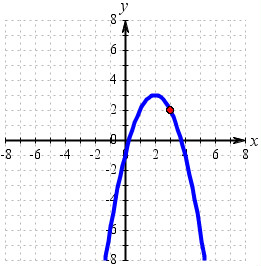Graphing Parabolas
Graph the parabola y = x2 - 4x on the interval [-1,5].
(Remember: [-1,5] means from x = -1 to x = 5 inclusive.)
Prepare a chart:
| x | x2 - 4x | y |
| -1 | (-1)2 - 4(-1) | 5 |
| 0 | (0)2 - 4(0) | 0 |
| 1 | (1)2 - 4(1) | -3 |
| 2 | (2)2 - 4(2) | -4 |
| 3 | (3)2 - 4(3) | -3 |
| 4 | (4)2 - 4(4) | 0 |
| 5 | (5)2 - 4(5) | 5 |
|
Plot the points generated in the chart. Draw a smooth curve through the points.
 The points where the graph crosses the The points where the graph crosses the
x-axis are called the roots of
0 = x2 - 4x.
This parabola crosses the x-axis
at (0,0) and (4,0).
|
|
In this example, the interval used for preparing the chart was given in the question. Consequently, the turning point of the parabola fell within the interval. If the question had NOT told us the interval, how would we have known which values to place in the chart to ensure that we would see the turning point of the parabola? To guarantee that the points you choose for your chart will show the turning point, start by determining the axis of symmetry of the parabola.
The axis of symmetry is a vertical line passing through the turning point of a parabola.
In our first example, the turning point was (2,-4). The equation of the axis of symmetry is the equation of the vertical line passing through (2,-4), or in this case x = 2.
Parabolas are of the quadratic form: y = ax2 + bx + c
|
|
|
|
If a is positive, the parabola opens upward and has a minimum point.
The axis of symmetry is x = (-b)/2a
|
If a is negative, the parabola opens downward and has a maximum point.
The axis of symmetry is x = (-b)/2a.
|
Example 2: Graph the parabola y = x2 + 6x - 1 (no interval specified)
Rather than picking numbers at random to form our chart of values, let's first find the axis of symmetry. This will guarantee that our chart will graph the turning point of the parabola and give us a good graph.
To find the axis of symmetry, use the formula x = -b/2a
In this example, a = 1 and b = 6.
Substituting gives: x = -(6)/2(1) = -6/2 = -3 Axis of symmetry: x = -3
Since the x-coordinate of the turning point is -3, use this value as the middle value for x in the chart. Include 3 values above and below -3 in the chart.
Substitute each value of x into the quadratic equation (the parabola), to find the corresponding values for y and complete the table. When the table is complete, plot the points and draw the graph.
|
|
Set up the table. |
x
|
y
|
-6
-5
-4-3-2
-1
0
|
-1
-6
-9
-10
-9
-6
-1
|
Complete the table.
|
 |
|
|





